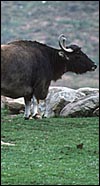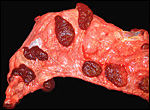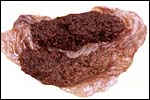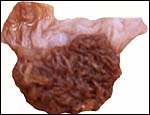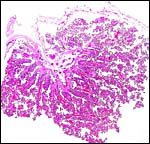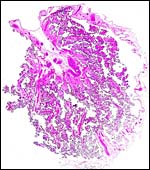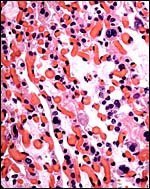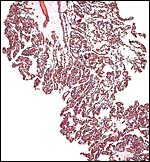| (Clicking
on the thumbnail images will launch a new window and a larger version
of the thumbnail.) |
| Last updated: March 21, 2007. |
Bubalus bubalis
Order: Artiodactyla
Family: Bovidae
1) General Zoological Data
The history, different breeds, distribution and uses of water buffaloes were admirably described in a readable paper by Cockrill (1967). Longevity is there described as being 40 years. The animals are widely distributed as beasts of burden and they are also maintained in many zoos. Groves (1996) examined and reviewed the wild water buffalo ( Bubalus arnee ) of India and some aspects of the domestic animals. He indicated that there is widespread crossbreeding between the wild and domestic species.
The phylogeny of Bubalus was restudied by Buntjer et al. (2002) in some detail, employing AFLP fingerprinting (amplified fragment length polymorphism). These authors reviewed also the earlier publications of bovid species. They confirmed that Bubalus and Syncerus split earliest and are more closely related one to another than cattle and bison. This split may have occurred as early as in the Miocene and the earliest buffalo to be considered was Bubalus platyceros according to Pilgrim (1947). Groves (1981) has additional systematic information.
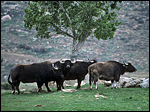 |
Water buffaloes at San Diego Zoo's Wild Animal Park. |
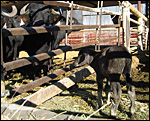 |
Water buffaloes from which the specimens that are here described stem. |
2) General Gestational Data
Water buffaloes usually have single births. But, the fact that Keller & Tandler (1916) were able to examine some twin placentas in Viennese abattoirs indicates that multiple pregnancies exist, and there are other records to that effect. Thus, Fischer & Adenil (1956) reported a set of monozygotic female twin and referred to an earlier report (Fischer, 1956). Fischer (1964) contended that twinning in Egyptian water buffaloes occurs at a rate of 0.2%, while in Indonesian Swamp buffaloes the rate is only 0.0002%, and in Malaysia 0.0003%. He here reported another three pairs of twins. Moreover, Iannuzzi et al. (2003) have now described six females with freemartinism and having the blood chimerism of freemartins (50,XY/50,XX).
A detailed study of ovulation and cycle length was conducted by Vale (1983) on Brazilian water buffaloes. Median cycle length was ~23 days; ovulation occurred usually at night. Numerous attempts at hybridizing water buffalo and cattle have been made. The most recent ones by Kochhar et al. (2002), Patil & Totey (2003), and Tatham et al. (2003) were done with in vitro methodology. Oocyte fertilization in both directions yielded some cleavage products and blastocysts, but no surviving embryos. The success rates differed depending on donor sperm, but expression of several genes failed to take place in the conceptus when this was looked for. Placental weights have not been recorded.
3) Implantation
Early stages of implantation are not available.
4) General Characterization of the Placenta
This single placenta available had 75 cotyledons that varied in size from 1to 4 cm. The female calf weighed 58 lbs. This is a typical polycotyledonary placenta with most cotyledons being oval in shape. General characters have been described by El-Naggar & Abdel-Raouf (1971).
5) Details of fetal/maternal barrier
Similar to many other artiodactyl species, the trophoblast beneath the chorionic surface is focally pigmented but has no hemosiderin staining. This is an epithelio-chorial type of placentation. Abd-Elnaeim et al. (2003) studied the vascular microarchitecture of cotyledons by preparing casts, and by electron microscopy. They differentiated between two types of cotyledons and were impressed with the extent of the capillary proliferation during advancing gestation. Likewise, numerous binucleate trophoblastic cells are present in the single-layered trophoblastic villous cover. The binucleate cells of water buffalo have not been studied directly, but Wimsatt (1951) described the general ruminant binucleate cells as being post-mitotic cells but having formed by mitotic activity. Their placenta lactogen production seems to be well established for the sheep, and Atkinson et al. (1993) suggested the production of a family of proteins by binucleate cells. Wooding (1982) reviewed the possible fusion of binucleate cells and endometrium, with granules moving to the maternal circulation. Pereira et al. (2001) suggested that apoptosis can be demonstrated in these cells. Quite recently, however, Carvalho et al. (2006) have paid special attention to the binucleate cells in this species throughout gestation. Their frequency increased with gestation to 27% and prominent endoplasmic reticulum was demonstrated. Antibodies to placental lactogen located to their cytoplasm. They often fused with endometrial epithelial cells and then they became trinucleate and apoptosis followed.
6) Umbilical cord
I do not know the length of the umbilical cord; it has four vessels and a large allantoic sac. Numerous small vessels are found additionally and these appear to arise from the larger vessels as seen in the next photograph.
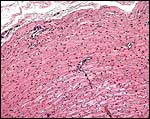 |
The umbilical arteries are being penetrated by the numerous mall-caliber cord blood vessels. |
7) Uteroplacental circulation
I am not aware of any unusual features or studies other than those already cited.
8) Extraplacental membranes
The placenta has a large vascularized allantoic sac. The amnion is avascular and covered by a single-layered epithelium.
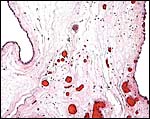 |
Amnion at left and chorionic membrane at right. |
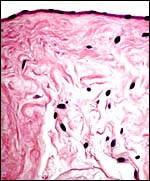 |
Amnionic membrane with single-layer epithelium, avascular. |
9) Trophoblast external to barrier
There is no extraplacental trophoblast infiltration of endometrium or myometrium.
10) Endometrium
The structure of uterine caruncles was described in great detail by Abdel-Raouf & Badawi (1966) who also reviewed the older literature. They described the arrangement in four rows in numerous animals collected from slaughterhouses, some were pregnant animals. A majority was oval, and gravid animals had between 71 and 229 (average 128). Nongravid uteri had 91-153 caruncles.
11) Various features
None.
12) Endocrinology
In a detailed study of Brazilian water buffalo reproduction, Vale (1983) measured progesterone levels. Presicce et al. (2003) studied follicular turnover and hormonal characteristics in water buffalo by sonography and estrogen and FSH measurements. Mondal & Prakash (2004) assessed the pulsatile secretion of growth hormone and luteinizing hormone during development. Comparative studies of buffalo and cattle ovarian cellular growth showed them to be generally similar, except for a reduced proliferation of theca cells in water buffalo. Keller & Tandler (1916) examined a few twin placentas of water buffalo in Vienna and found no anastomoses, nor evidence of freemartinism in that species, in contrast to their report on cattle. On the other hand, Iannuzzi et al. (2003) more recently described six females with freemartinism and blood chimerism (50,XY/50,XX).
13) Genetics
There are several karyotypes of water buffalo, indicating its process of speciation. Both shown here (2n-50 and 2n=48) come from our Mammalian Chromosome Atlas (Hsu & Benirschke, 1969, 1970) but ultimately they came from Dr. Ulbrich in Giessen (Fischer & Ulbrich, 1968). A Robertsonian fusion, leading to the large metacentrics in the second animal, probably explains the variation; hybrids are fertile but apparently somewhat difficult to produce. Koulischer (1971) depicted the karyotype of an animal with 2n=50, and Toll & Handler (1976) also found 2n=50 in the Swamp buffalo and depicted Giemsa banding. Bongso (1977) found 2n=48 and 2n=50 for river buffaloes in Sri Lanka . Di Berardino & Iannuzzi (1984) described 2n=50 and described the RBA-banding patterns, and Di Berardino et al. (1981) compared Ag-NORs of buffalo with those of cattle. Earlier (1981), they had compared animals with 48 and 50 chromosomes. The older literature is there considered as well. Di Meo et al. (2002) did some chromosomal mapping of buffalo and sheep; more recently, Iannuzzi et al. (2003) assigned 64 loci to chromosomes of “river” buffalo ( Bubalus bubalis ) with 2n=50 and goat, indicating great conservatism in chromosomal evolution. Later (2004), these authors described two chromosomal errors and compared these with the few earlier reports. One error was a female with 51, XXX; the other a “female” with 50,XY in which Swyer's syndrome was suggested. Chromosome preparations were made from lymphocytes; thus, the possibility of this being a freemartin exists, as twinning occurs in this species. In the few specimens of twin placentation reported by Keller & Tandler (1916), no anastomoses were found, but too few specimens were then studied. Interestingly, however, Iannuzzi et al. (2003) described six females with freemartinism and blood chimerism (50,XY/50,XX). Revay et al. (2003) made probes for FISH from yak chromosomes and were able to localize the Y-chromosome in spermatozoa. Horng et al. (2004) cloned a male-specific DNA sequence, and Manna et al. (2003) used PCR for embryo sexing. Modi et al. (2004) described the evolution of a satellite repeat structure of the DNA in cow and various related species.
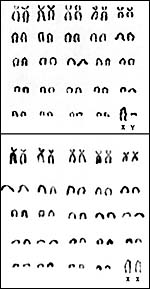 |
Karyotypes of Murrah buffalo, an Indian dairy breed. 2n=50. |
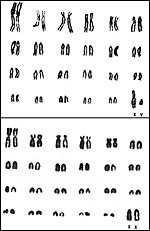 |
Karyotypes of Asiatic swamp buffalo in Thailand . 2n=48. |
14) Immunology
Non-classical MHC class I leukocyte antigens were expressed in the placenta of late pregnancy (Braga et al., 2003).
15) Pathological features
Numerous infectious illnesses have been described in the widely used water buffalo. Thus, glomerulonephritis due to infection with Fasciola hepatica was described by Marques et al. (2004). Griner (1983) remarked upon the great breeding success of water buffalo at San Diego and described one neonate with hydrocephalus and an adult dying from lymphosarcoma. In the admirable review of water buffalo by Cockrill (1967), rinderpest, sepsis, anthrax and foot-and-mouth disease are listed as special threats.
16) Physiologic data
The quality of sperm during ART was described Herold et al. (2004) and by Hufana-Duran et al. (2004). While cloning has not yet succeeded in water buffalo, Gasparrini et al. (2004) and Saikhun et al. (2004) described attempts in this direction, so far unsuccessful. Datta & Stone (1963) made initial studies on blood grouping.
17) Other resources
Only few cell strains of water buffalo are available from CRES by contacting Dr. Oliver Ryder at oryder@ucsd.edu . Most specimens available are of the related anoa.
18) Other remarks
Data are needed on the weights of placentas, lengths of umbilical cords, and on early implantations.
Acknowledgement
The animal photographs in this chapter come from the Zoological Society of San Diego. I am most grateful to Drs. Robert BonDurant and Dalen Agnew (UC Davis) for providing this placenta.
References
Abdel-Raouf, M. and Badawi, H.M.: Morphological study of uterine caruncles in Egyptian buffalo cows. Zentralbl. Veterinärmed. 13 :252-263, 1966.
Abd-Elnaeim, M.M., Miglino, M.A., Pfarrer, C. and Leiser, R.: Microvascular architecture of the fetal cotyledons in water buffaloes (Bubalus bubalis) during different stages of pregnancy. Ann. Anat. 185 :325-334, 2003.
Atkinson, Y.H., Gogolin-Ewens, K.J., Hounsell, E.F., Davies, M.J., Brandon , M.R. and Seamark, R.F.: Characterization of placentation-specific binucleate cell glycoproteins possessing a novel carbohydrate. J. Biol. Chem. 268 :26679-26685, 1993.
Bongso, T.A.: The karyotype of the indigenous buffalo (Bubalus bubalis) of Sri Lanka . Ceylon Vet. J.: 25 :9-11, 1977.
Braga , F.C., Miglino, M.A., Puelker, R.Z., Verechia, F.T. and Meirelles, F.V.: Non-classical MHC class I in water buffalo placenta. Placenta 24 :p. A6, abstract O13, 2003.
Buntjer, J.B., Otsen, M., Nijman, I.J., Kuiper, M.T.R. and Lenstra, J.A.: Phylogeny of bovine species based on AFLP fingerprinting. Heredity 88 :46-51, 2002.
Carvalho, A.F., Klisch, K., Miglino, M.A., Pereira , F.T. and Bevilacqua, E.: Binucleate trophob;ast giant cells in the water buffalo (Bubalus bubalis). J. Morphol. 267:50-56, 2006.
Cockrill, W.R.: The water buffalo. Scientific American pp. 118-125, 1967.
Datta, S.P. and Stone, W.H.: Blood-typing of Indian water buffaloes with reagents for antigenic factors of cattle. Nature 199 1208-1209, 1963.
Di Berardino, D., Iannuzzi, L., Bettini, T.M. and Matassino, D.: Ag-NORs variation and banding homologies in two species of Bovidae: Bubalus bubalis and Bos taurus. Can. J. Genet. Cytol. 23 :89-99, 1981.
Di Berardino, D. and Iannuzzi, L.: Chromosome banding homologies in Swamp and Murrah buffalo. J. Hered. 72 :183-188, 1981.
Di Berardino, D. and Iannuzzi, L.: Detailed description of RBS-banded chromosomes of river buffalo (Bubalus bubalis L.). Génét. Sél. Evol. 16 :249-260, 1984.
Di Meo, G.P., Perucatti, A., Incarnato, D., Ferretti, L., Di Berardino, D., Caputi Jambrenghi, A., Vonghia, G. and Iannuzzi, L.: Comparative mapping of twenty-eight bovine loci in sheep (Ovis aries, 2n=54) and river buffalo (Bubalus bubalis, 2n=50) by FISH. Cytogenet. Genome Res. 98 :262-264, 2002.
El-Naggar, M.A. and Abdel-Raouf, M.: Foetal membranes and fluids in Egyptian buffalo. Zentralbl. Vet. Med. 18 :108-123, 1971.
Feranil, J., Isobe, N. and Nakao, T.: Cell proliferation in the atretic follicles of buffalo and cattle ovary. Reprod. Domest. Anim. 39 :405-409, 2004.
Fischer, H.: Büffelzwillinge mit Euterhypoplasien. Berl. & Münch. Tierärztl. Wschr. 69 :89, 1956.
Fischer, H.: Water buffalo twins. The MAHA Magazine 21 63, 1964.
Fischer, H. and Adenil, C.: A new case buffalo twins on the island of Sumba . Hemera Zoa 63 :446-449, 1956.
Fischer, H. and Ulbrich, F.: Chromosomes of the Murrah buffalo and its crossbreds with the Asiatic Swamp buffalo (Bubalus bubalis). Z. Tierz. Züchtungsbiol. 84 :110-114, 1968.
Gasparrini, B., Boccia, L., Rosa , A.D., Palo, R.D., Campanile, G. and Zicarelli, L.: Chemical activation on buffalo (Bubalus bubalis) oocytes by different methods: effects of aging on post-parthenogenetic development. Theriogenology 62 :1627-1637, 2004.
Griner, L.A. : Pathology of Zoo Animals. Zoological Society of San Diego , San Diego , California , 1983.
Groves , C.P.: Systematic relationships in the Bovini (Artiodactyla, Bovidae). Z. zool. Systematik Evolutionsforsch. 19 :264-278, 1981.
Groves , C.P.: The taxonomy of the Asian wild buffalo from the Asian mainland. Z. Säugetierk. 61 :327-338, 1996.
Herold, F.C., De Haas, K., Cooper, D., Colenbrander, B., Nothling, J.O., Theunisen, W., Spillings, B. and Gerber, D.: Comparison of three different media for freezing of epididymal sperm from the African buffalo (Syncerus caffer) and influence of equilibrium time on the post-thaw sperm quality. Onderstepoort J. Vet. Res. 71 : 203-210, 2004.
Horng, Y.M., Chen, Y.T., Wu, C.P., Jea, Y.S. and Huang, M.C.: Cloning of Taiwan water buffalo male-specific DNA sequence for sexing. Theriogenology 62 :1536-1543, 2004.
Hsu, T.C. and Benirschke, K.: An Atlas of Mammalian Chromosomes. Springer-Verlag , New York . Vol. 3, Folio 139, 1969; Volume 4, Folio 189, 1970.
Hufana-Duran, D., Pedro, P.B., Venturina, H.V., Hufana, R.D., Salazar, A.L., Duran, P.G. and Cruz, L.C.: Post-warming hatching and birth of live calves following transfer of in vitro-derived vitrified water buffalo (Bubalus bubalis) embryos. Theriogenology 61 :1429-1439, 2004.
Iannuzzi, L., Di Meo, G.P., Perucatti, A., Schibler, L., Incarnato, D., Gallagher, D., Eggen, A., Ferretti, L., Cribiu, E.P. and Womack, J.: The river buffalo (Bubalus bubalis, 2n=50) cytogenetic map: assignment of 64 loci by fluorescence in situ hybridization and R-banding. Cytogenet. Genome Res. 102 :65-75, 2003.
Iannuzzi, L., Di Meo, G.P., Perucatti, A., Di Palo, R. and Zicarelli, L.: Clinical cytogenetics in river buffalo (Bubalus bubalis , 2n=50): new cases. Abstract of 15 th ECACGM meeting pp. 27-28, 2003.
Iannuzzi, L., Di Meo, G.P., Perucatti, A., Schibler, L., Incarnato, D., Di Palo, R. and Zicarelli, L.: Reproductive disturbances and sex chromosome abnormalities in two female river buffaloes. Vet. Rec. 154 :823-824, 2004.
Keller, K. and Tandler, J.: Über das Verhalten der Eihäute bei der Zwillingsträchtigkeit des Rindes. Wien. tierärztl. Mschr. 3 :513-527, 1926.
Kochhar, H.P., Rao, K.B., Luciano, A.M., Totey, S.M., Gandolfi, F., Basrur, P.K. and King, W.A.: In vitro production of cattle-water buffalo (Bos taurus – Bubalus bubalis) hybrid embryos. Zygote 10 :155-162, 2002.
Koulischer, L.: Clonal cellular evolution and speciation in mammals: Cytogenetic analogies. Boll. Zool. (Ital.) 38 :311-316, 1971.
Manna, L., Neglia, G., Marino, M., Gasparrini, B., Di Palo, R. and Zicarelli, L.: Sex determination of buffalo embryos (Bubalus bubalis) by polymerase change reaction. Zygote 11 :17-22, 2003.
Marques, S.M., Scroferneker, M.L. and Edelweiss, M.I.: Glomerulonephritis in water buffalo (Bubalus bubalis) naturally infected by Fasciola hepatica. Vet. Parasitol. 123 :83-91, 2004.
Modi, W.S., Ivanov, S. and Gallagher, D.S.: Concerted evolution and higher-order repeat structure of the 1.709 (satellite IV) family in bovids. J. Mol. Evol. B58 :460-465, 2004.
Mondal, M. and Prakash, B.S.: Changes in plasma growth hormone (GH) and secretion patterns of GH and luteinizing hormone in buffaloes (Bubalus bubalis) during growth. Endocr. Res. 30 :301-313, 2004.
Patil, S. and Totey, S.: Developmental failure of hybrid embryos generated by in vitro fertilization of water buffalo (Bubalus bubalis) oocyte with bovine spermatozoa. Mol. Reprod. Dev. 64 :360-368, 2003.
Pereira , F.T.V., Miglino, M.A., Carvalho, A.F. and Petroni, N.: Apoptosis in a water buffalo placenta. Placenta 22 : p.A32, abstract P96, 2001.
Pilgrim, G.E.: The evolution of the buffaloes, oxen, sheep and goats. Linn. Soc. Zool. 41 :272-286, 1947.
Presicce, G.A., Parmeggiani, A., Senatore, E.M., Stecco, R., Barile, V.L., De Mauro, G.J., De Santis, G. and Mario Terzano, G.: Hormonal dynamics and follicular turnover in prepuberal Mediterranean Italian buffaloes (Bubalus bubalis). Theriogenology 60 :485-493, 2003.
Saikhun, J., Kitiyanant, N., Songtaveesin, C., Pavasuthipaisit, K. and Kitiyanant, Y.: Development of swamp buffalo (Bubalus bubalis) embryos after parthenogenetic activation and nuclear transfer using serum fed or starved fetal fibroblasts. Reprod. Nutr. Dev. 44 :65-78, 2004.
Tatham, B.G., Feehan, T. and Pashen, R.: Buffalo and cattle hybrid embryo development is decreased by caffeine treatment during in vitro fertilization. Theriogenology 59 :709-717-2003.
Toll, G.L. and Halnan, R.E.: The karyotype of the Australian Swamp buffalo (Bubalus bubalis) Can. J. Genet. Cytol. 18 :101-104, 1976.
Toll, G.L. and Halnan, R.E.: The Giemsa banding pattern of the Australian Swamp buffalo (Bubalus bubalis): Chromosome homology with other Bovidae. Can. J. Genet. Cytol. 18 :303-310, 1976
Vale, W.G.: Zyklus, Dauer und Symptome der Brunst sowie Zeitpunkt der Ovulation bei Wasserbüffelkühen (Bubalus buablis) auf der Marajó-Insel, Nordbrasilien. Dissertation, Veterinary School , Hannover , Germany , 1983.
Wimsatt, W.A.: Observations on the morphogenesis, cytochemistry, and significance of the binucleate giant cells of the placenta of ruminants. Amer. J. Anat. 89 :233-282, 1951.
Wooding, F.B.: The role of the binucleate cell in ruminant placental structure. J. Reprod. Fertil. Suppl. 31 :31-39, 1982.
